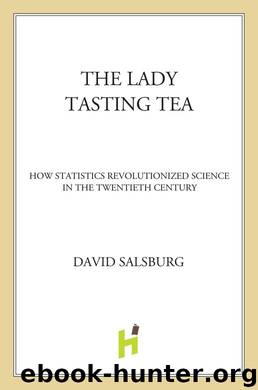The Lady Tasting Tea by David Salsburg

Author:David Salsburg
Language: eng
Format: epub
Publisher: Henry Holt and Co.
Published: 2011-10-27T16:00:00+00:00
JEROME CORNFIELD
Many of the new young workers who arrived in Washington during the New Deal went on to become major figures in government and in academia. Some of them were too busy creating new mathematics and statistical methods to go for graduate degrees. A prime example is Jerome Cornfield. Cornfield participated in some of these early surveys at the Bureau of Labor Statistics and then moved to the National Institutes of Health. He published papers jointly with some of the leading figures in academia. He solved the mathematical problems involved in case-control studies. His scientific papers range from work on random sample theory to the economics of employment patterns, the investigation of tumors in chickens, problems in photosynthesis, and effects of environmental toxins on human health. He created many of the statistical methods that have now become standard in the fields of medicine, toxicology, pharmacology, and economics.
One of Cornfield’s most important achievements was in the design and initial analysis of the Framingham Study, begun in 1948. The idea was to take Framingham, Massachusetts, as a “typical town,” measure a large number of health variables on everyone in the town, and then follow these people for a number of years. The study has now been running for over fifty years. It has had a “Perils of Pauline” existence as, from time to time, attempts have been made to cut its funding in the interests of budget reduction in government. It remains a major source of information on the long-term effects of diet and lifestyles on heart disease and cancer.
To analyze the first five years of data from the Framingham Study, Cornfield ran into fundamental problems that had not been addressed in the theoretical literature. Working with faculty members at Princeton University, he solved these problems. Others went on to produce papers on the theoretical development he started, but Cornfield was satisfied to have found a method. In 1967, he was a coauthor of the first medical article to emerge from the study, the first article to show the effects of elevated cholesterol on the probability of heart disease.
I was on a committee with Jerry Cornfield, convened in 1973 as part of a set of hearings before a Congressional committee. During a break in our work, Cornfield was called to the phone. It was Wassily Leontief, an economist at Columbia University, calling to say that he had just been awarded the Nobel Prize in economics and wanted to thank Cornfield for the role Jerry had played in their work, which led to this prize. This work had originated in the late 1940s when Leontief had come to the Bureau of Labor Statistics for help.
Leontief believed that the economy could be broken down into sectors, like farming, steel manufacturing, retailing, and so forth. Each sector uses material and services from the other sectors to produce material or a service, which it supplies to those other sectors. This interrelationship can be described in the form of a mathematical matrix. It is often called an “input—output analysis.
Download
This site does not store any files on its server. We only index and link to content provided by other sites. Please contact the content providers to delete copyright contents if any and email us, we'll remove relevant links or contents immediately.
| Biomathematics | Differential Equations |
| Game Theory | Graph Theory |
| Linear Programming | Probability & Statistics |
| Statistics | Stochastic Modeling |
| Vector Analysis |
Modelling of Convective Heat and Mass Transfer in Rotating Flows by Igor V. Shevchuk(6376)
Weapons of Math Destruction by Cathy O'Neil(6116)
Factfulness: Ten Reasons We're Wrong About the World – and Why Things Are Better Than You Think by Hans Rosling(4674)
Descartes' Error by Antonio Damasio(3209)
A Mind For Numbers: How to Excel at Math and Science (Even If You Flunked Algebra) by Barbara Oakley(3206)
Factfulness_Ten Reasons We're Wrong About the World_and Why Things Are Better Than You Think by Hans Rosling(3185)
TCP IP by Todd Lammle(3117)
Fooled by Randomness: The Hidden Role of Chance in Life and in the Markets by Nassim Nicholas Taleb(3025)
Applied Predictive Modeling by Max Kuhn & Kjell Johnson(3004)
The Tyranny of Metrics by Jerry Z. Muller(2982)
The Book of Numbers by Peter Bentley(2897)
The Great Unknown by Marcus du Sautoy(2631)
Once Upon an Algorithm by Martin Erwig(2585)
Easy Algebra Step-by-Step by Sandra Luna McCune(2560)
Lady Luck by Kristen Ashley(2513)
Practical Guide To Principal Component Methods in R (Multivariate Analysis Book 2) by Alboukadel Kassambara(2485)
Police Exams Prep 2018-2019 by Kaplan Test Prep(2467)
All Things Reconsidered by Bill Thompson III(2345)
Linear Time-Invariant Systems, Behaviors and Modules by Ulrich Oberst & Martin Scheicher & Ingrid Scheicher(2321)
